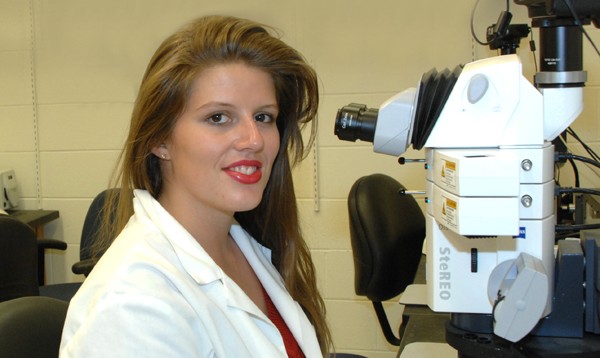
Conquering Cancer Remembering A Friend
Finding a cure for cancer is Crystal Jones-Sotomayor’s dream.
It’s been a dream since she was a sophomore in high school in Aguadilla, Puerto Rico – after she lost her childhood friend to breast cancer.
“I remember asking Michelle what she wanted to be when she grew up. She said ‘I don’t know, but I want to be in the history books like Christopher Columbus,’ says Jones-Sotomayor, a junior in genetics. “My hope is to do that for her.”
Cancer develops when a cell’s DNA is damaged causing it grow out of control, form abnormal cells and invade the body. It’s that DNA or genetic code that interests Jones-Sotomayor. In fact, she keeps a diagram of a cell in her laptop and on her cell phone. The diagram illustrates the countless genetic pathways cancer can enter a cell.
Genetics has fascinated her since grade school when she learned about the Punnett Square. The square is a simple method to diagram inherited traits and determine the probability of those traits being passed on to children.
“I absolutely loved the Punnett Squares in elementary school because you could visually see the dominant and recessive traits,” Jones-Sotomayor says. “I have always been a curious person and science is about asking questions.”
After her friend died, Jones-Sotomayor began looking for a top-rated genetics university program in the United States. That search led her to Iowa State University and Maura McGrail’s research lab, which is filled with 40,000 zebrafish. The zebrafish allow scientists to do genetics research on a large scale but at a reduced cost compared to other animal models used in cancer research. (Read more about McGrail’s work on page 27.)
Jones-Sotomayor met McGrail at an ice cream social hosted by her adviser when she was a freshman. She knew immediately that she wanted to be part of McGrail’s lab because they both had a common goal – searching for a cure for cancer. McGrail describes Jones-Sotomayor, who has been a part of her lab for more than three years, as a forward-thinking creative researcher who started out doing basic genetic mapping.
“Crystal uses cutting edge genome editing technology to create specific mutations in genes,” says McGrail, assistant professor in genetics, development and cell biology.
Jones-Sotomayor isolated a new mutation in a cancer gene identified in zebrafish and found the fish that inherit the new mutation also develop tumors.
“This result was really critical, because it validated our initial discovery that mutation of this gene promotes cancer,” says McGrail.
When asked about the mutant gene, Jones-Sotomayor gets excited. She goes into great detail about cutting genes and watching for brain-tumor development in the fish. She explains how Transcription activator-like effector nuclease (TALEN) technology, which is used to cut and introduce mutations in the DNA code, helped her isolate the new mutation. TALEN technology was developed by plant pathologists at Iowa State.
In a lab filled with small aquariums, Jones-Sotomayor points out the zebrafish she’s watching.
“The idea was to cross those fish to find one that would transmit the new mutant gene to their offspring. After crossing and screening the offspring from 260 fish, I found it,” Jones-Sotomayor says.
“At this point we don’t have enough information to say exactly how the gene is involved in cancer,” Jones-Sotomayor says. “What I’m doing now is testing how this gene connects with cancer genes that control cell growth or repair damage to DNA.”
During her short career she’s presented her research results at six conferences, including the national Society for Advancement of Hispanics/Chicanos and Native Americans in Science conference in Los Angeles in October. She also won third place for a poster presentation at the 2013 Louis Stokes Alliance for Minority Participation IINSPIRE program.
Research is what Jones-Sotomayor is about, she says her friends got tired of hearing about genetics so she started tutoring genetics students. She helps students with real life examples and videos because it’s a difficult topic to understand.
“It’s great because I get paid to talk about genetics,” Jones-Sotomayor says.
She also formed the iResearch club, a student organization for young scientists. She’s hoping the club will give her peers a place to share research, results and challenges.
Jones-Sotomayor has worked in McGrail’s lab since she first came to Iowa State three years ago. She has a natural talent for lab research, but was struggling with class work. She’s worked hard over the last three years and is now making the Dean’s list.
Last summer she worked as an intern studying the use of specific viruses to combat cancer at the University of Florida. That experience introduced her to a different approach to researching cancer and will add to her resume when she applies for graduate school.
Finding a cure for cancer won’t be simple, but she hopes researchers find some answers in her lifetime. And she’s hoping to make a discovery to contribute to that goal and honor her friend.



